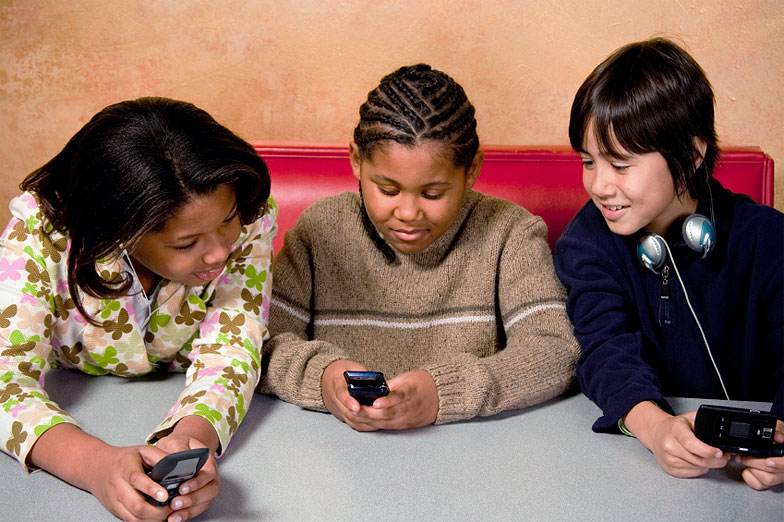If you ask a group of students what they love about texting and what they can’t stand, you’ll get an earful! Texting offers some interesting challenges for middle school students as they develop and practice social and emotional interactions with one another. How can we help our middle level students navigate these challenges of texting?
Before our students are on social media such as Twitter and Facebook they are usually already texting. Even devices that are not technically cell phones can offer students the opportunity to send text messages. Kids in fourth, fifth and sixth grade (and beyond) will often “group text” with huge numbers of peers, some that they may not even know in person.
Starting a classroom conversation about texting can help students share and learn together the best ways to navigate the world of texting. Teachers could
- Have students discuss texting in “pair shares”
- Visit with students asking for pros and cons from every student (if you have a small enough group)
- Include as an essay topic the things students like or don’t like about texting
In addition, here are some structured exercises and discussion topics that can help students learn great tools for being a super-polite texter and a better friend:
- Invent Your Own App
I love doing this exercise with kids. Pose a question or describe a texting problem to them, then ask “What app would you invent to fix this?” One group of kids I worked with invented an app to deal with the challenges of group texts. They offered a way to “step out” temporarily (to do homework or take a shower) without coming back to 900 texts. They also offered a feature for getting out completely, and a reminder about who is participating (since you only see phone numbers for contacts not in your address book) so they would know not to talk about those individuals … really clever stuff … and it’s such a great exercise to make them cognizant of the pitfalls of texting. - Boundaries Challenge
Ask them to explain how they can identify and express boundaries. Two important boundaries are time and availability. Kids need to know that they don’t have to be responsive 24/7. How can they construct some simple language for expressing a clear boundary to peers? For example, “I can’t respond to texts after 9:00 pm.” or “I don’t group text.” Not only does this teach them about boundaries (useful in general too!), but it also helps them feel less worried about how they will be perceived if they don’t respond right away. Another set of boundaries is social. What kinds of conversations do we not want to be part of via text, IM, or other digital (and highly shareable) modes? When might a student want to say, “I can’t be part of a chat if there is mean talk about other kids.” etc. Their need for inclusion makes it difficult for students to come up with this on their own, so it’s a great opportunity for them to have space at school to think through the role of texting in their lives. - Function vs. Emotion Discussion
Ultimately, we want to teach our students that text messaging is a great way to stay in touch and feel connected to your peers. It’s great for quick exchanges, planning, and meeting up. In other words, it has functional and practical uses. Emotional issues, on the other hand, don’t translate well in text messages or social media. They are too complex for such a simple medium. Talk with students about sticking with the functional aspects. That doesn’t mean that you can’t show support for a friend with a well-timed smiley emoticon, but talk with your kids about different situations so they can get a feel for what’s appropriate and what’s not. - Conflict Discussion
It is especially important that when kids have a conflict, they can use skills to mend fences in person. A sense of urgency can take over when trying to resolve a dispute. It can escalate quickly. Ask your students to think of examples when it is better to exercise restraint, be patient, and resolve the issue in a face-to-face discussion. The phone can work too, but it’s extremely difficult to successfully resolve an argument via text message. Suggest to your students that they can avoid escalating a conflict with a simple message such as, “Texting might not be the best way to discuss this—can we talk F2F?”Conflicts can be very intense when they can be so easily shared. Other students may be all too eager to look in from the sidelines. Ask your students if they have ever felt “recruited” into other people’s conflicts? What if a nasty exchange erupts as part of a group text, or someone posts a rude comment on someone else’s Instagram picture? Do you get involved? Will that help or make it worse? As I often say, conflict can be a spectator sport.
Texting can be fun and fulfilling if our students understand how to use it correctly. It can be an important part of their social sphere, so it’s worth investing the time to help them learn the unwritten rules. You’ll find that students are eager to have a space to discuss the challenges that texting can bring.
Devorah Heitner, PhD , founder and CEO of Raising Digital Natives, specializes in providing educators and families guidance and resources that help children thrive in our increasingly digital world. Her curriculum, Connecting Wisely, is used in schools across the United States. Watch for an upcoming webinar by Devorah Heitner on Social/Emotional Perspectives on Digital Citizenship for Middle Level Students in March 2016.
